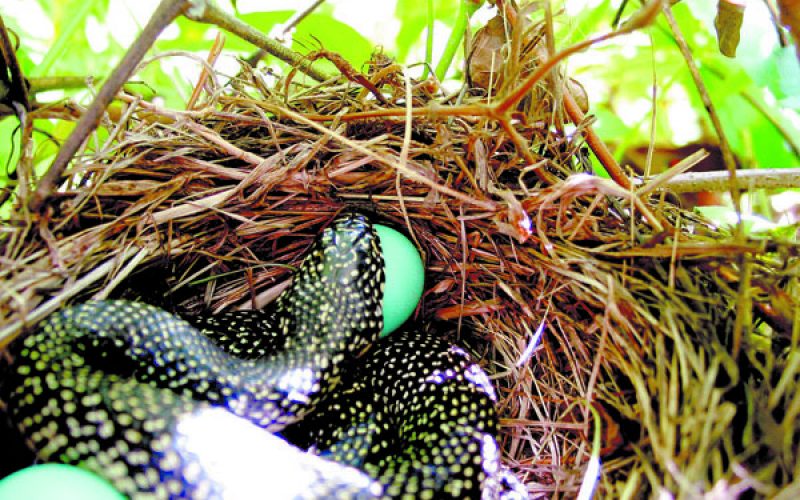Not everyone wants a snake for a neighbor. But if you have kingsnakes (one word) in your neighborhood, you might start thanking your lucky charms. These remarkable reptiles are not only an important part of our native ecology, they can also play a small role in protecting our human interests.
What makes kingsnakes so phenomenal for humans? First, they eat other snakes and will gladly eat venomous snakes – they’re immune to the venom. As the saying goes, the enemy of my enemy is my friend. Yet all snakes have a role to play in nature, and just like most other snakes, kingsnakes do their part in controlling the rodent population. They also prey on lizards and birds, sometimes raiding nests.

Photo by Michael Storey
A speckled kingsnake invades a robin’s nest and helps itself to
breakfast, lunch and dinner recently. The photo was taken in a Little Rock backyard. The nest was built on a fence in a clump of honeysuckle next to a gate and only about five feet off the ground.
We have two kingsnakes common in Northwest Arkansas: the prairie kingsnake and the speckled kingsnake, neither of which are venomous. But they might fool you: don’t be alarmed if you think you hear rattling or see their tails shaking like a rattlesnake. According to the Arkansas Game and Fish Commission, “Kingsnakes and rat snakes will often vibrate their tails when threatened, and when this is done against dried leaves or similar material, the result can sound like a rattlesnake.” Our only local venomous snakes are eastern copperhead, northern cottonmouth, Western diamondbacked rattlesnake, timber rattlesnake and Western pygmy rattlesnake. Thus, most of the snakes you encounter are likely harmless.
Prairie kingsnakes (also called mole snakes) are brown with blotches and the head is small compared to its body. They don’t have as much of a taste for eating other snakes as some of their kingsnake kin do. HerpsofArkansas.com explains that, “Despite the name prairie kingsnake, this species can be found in a variety of habitats, including woodland, agricultural fields, or natural prairies.”
Speckled kingsnakes (also called salt-n-pepper snakes) are quite attractive, with striking yellow spots against a black background and smooth scales. They’re often found under flat rocks or wood piles, and make their home in woodland, prairie, or lowland habitats. Unlike the Prairie kingsnakes, speckled kingsnakes are well known for their tendency to eat other snakes and may even eat members of their own species! They emit a musk when defensive, which sometimes helps to locate the snake if you’re gardening around rocks and suddenly smell it.
It can be challenging to properly identify snakes if you’re not familiar with them. To be on the safe side, be sure and let snakes lie where they are — don’t try to capture them or kill them, because more people are bitten during these activities than any others (such as while hiking or gardening). They’re probably just basking on a rock and enjoying the nice weather like any human in a hammock; allowing them some space could save you a lot of trouble, and in the case of kingsnakes, make the area around your home a little bit safer from venomous snakes.
Ripples is an emerging online educational center inspired by a holistic approach to making a difference. Follow our journey to live sustainably and make ripples with our lifestyle at: www.RipplesBlog.org.











